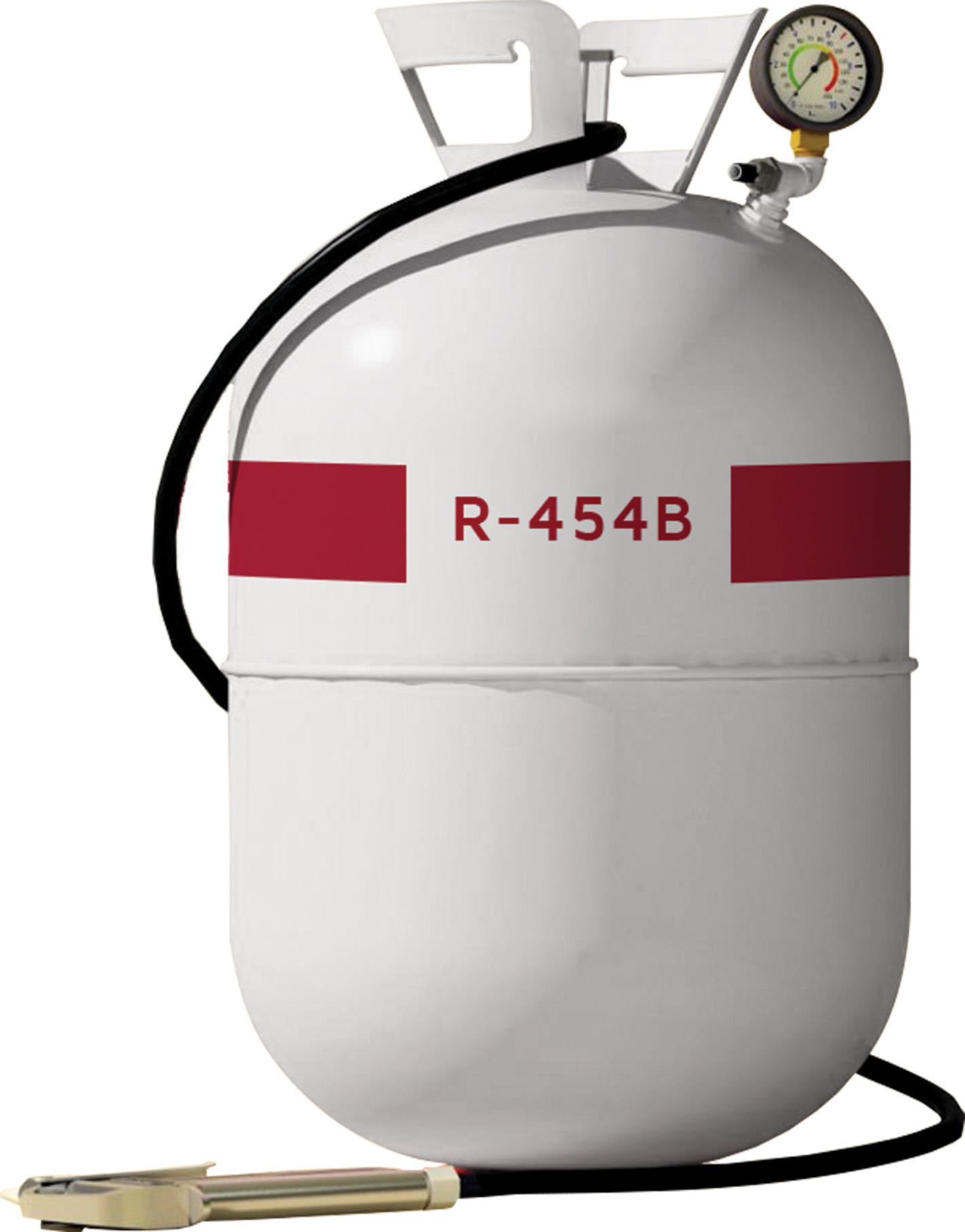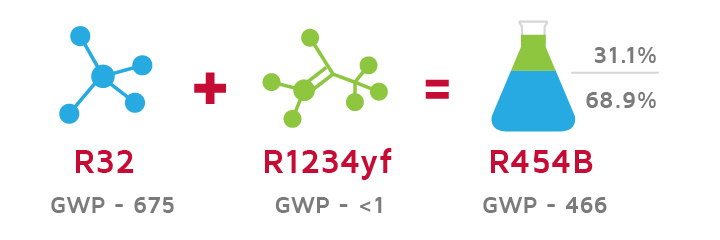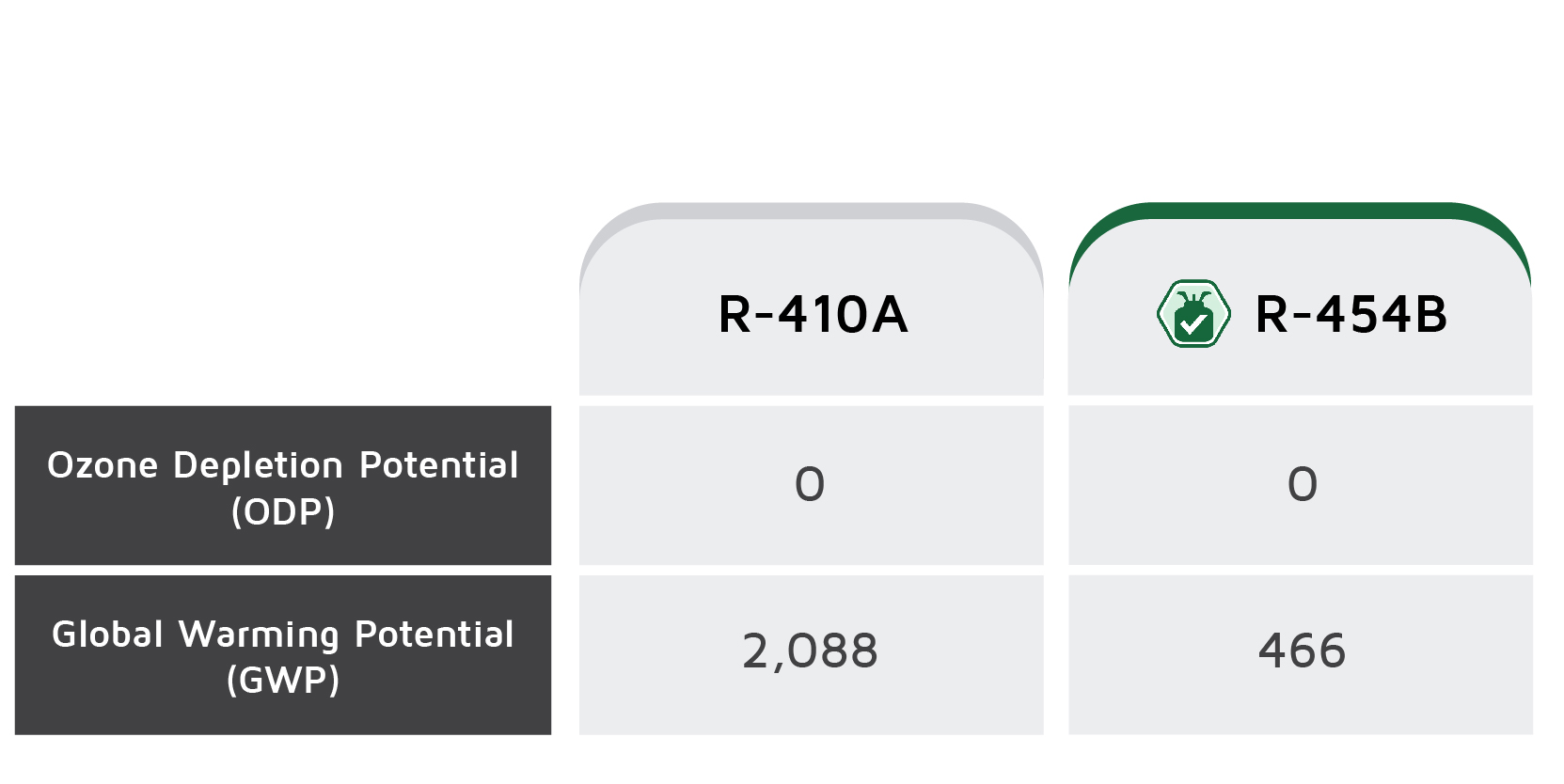First, we should have a basic understanding of refrigerant and the refrigerant story. Refrigerant is the fluid used in HVAC systems to cool warm air. As it circulates within a unit’s coils, it pulls heat from the air allowing the system to reduce or increase the temperature within a space by way of condensation or evaporation – depending on the desired temperature settings.
Since the early 20th century, chemical refrigerant compounds have been used in commercial and residential heating and cooling. The first widely used refrigerant was called R-22. As science became more and more aware of the effects of refrigerant on the ozone layer and climate in general, the government, by way of the Environmental Protection Agency began regulating refrigerant development and use. This oversight has driven the industry to develop more environmentally friendly compounds including R-454B – the refrigerant much of the industry is currently transitioning to in order to meet the latest EPA mandates.

To learn more about refrigerant and its history, visit our refrigerant glossary post.
What is R-454B?
R-454B is one of a group of recently developed refrigerants formulated to help reduce the environmental impact of HVAC systems and the HVAC industry as a whole. The measure of the impact a refrigerant has on the environment is called its Global Warming Potential (GWP). GWP is a system used to rate a refrigerant compound’s impact on climate change as compared to CO2, the primary greenhouse gas.
In simple terms, R-454B is an optimized mixture of two other refrigerants – R-32, a hydrofluorocarbon (HFC), and R-1234yf a hydrofluoroolefin (HFO). The resulting compound has a much lower GWP, and thus significant environmental advantages over previously used refrigerants like R-22 and R-410A. Because of these advantages, R-454B is quickly becoming the new industry standard in air conditioners and heat pumps across the industry.

* R-32, also developed recently, is a hydrocarbon refrigerant that can be used in both ductless and ducted systems.
Why the Switch to R-454B?
In 2020, as part of a global agreement to reduce greenhouse gasses, the American Innovation and Manufacturing (AIM) Act gave the US EPA the authority to regulate hydrofluorocarbons (HFCs) and begin the phase down of refrigerants with high HFCs with the ultimate goal of an 80% reduction in overall GWP by 2036. R-454B represents just one step toward this goal, answering a requirement that manufacturers switch to an alternate refrigerant with a GWP of 700 or less by 2025.
As we mentioned, R-454B significantly reduced environmental impact when compared to previous refrigerant compounds. R-454B has:
A GWP Rating of Just 466
R-454B’s GWP rating is 78% lower than previous standard compounds, and easily surpasses the EPA’s 2025 requirements.
Zero ODP and Low Toxicity
Like its predecessor R-410A, R-454B poses no danger to the ozone layer.
These advantages that led Lennox to adopt R-454B as our primary 2025 Compliant Refrigerant for whole-home systems and R-32 for our ductless mini-split systems. Both compounds have a lower GWP than our previous refrigerants and are formulated to provide excellent, reliable performance over time.
Along with the substantial environmental benefits, there are also other aspects of R-454B that make it the best choice.
Cost Impact
While the initial cost of R-454B is higher than R-410A, that expense will be made up for over time as R-410A refrigerant gets phased out causing an increase in price for R-410A replace/repairs parts.
It’s also important to keep in mind that this price imbalance is likely temporary. As the industry transitions to R-454B, supply chain, manufacturing and other factors will become less costly. At the same time, R-410A and other older refrigerants that are being phased out will become scarcer. Eventually the balance will shift, making R-454B the cheaper up-front option.
Safety
Unlike its predecessor, R-454B has an A2L safety classification. A2L refers to refrigerants with low toxicity and low flammability levels.
Additionally, R-454B is a non-toxic compound that is harmless to breathe in the event of a leak.
R-454B is, however, slightly more flammable than R-410A. Because of this, Lennox’ R-454B systems will come pre-equipped with leak detection systems. In addition, technicians will be trained on compound-specific safety measures and handling procedures to ensure safe installation and maintenance and minimize potential hazards.
What Does the R-454B Transition Mean for You?
Unfortunately, existing systems can’t be modified or retrofitted to work with R-454B. Due to the characteristics and system requirements of R-454B such conversions aren’t feasible.
But not to worry. The AIM Act timeline is designed to allow for a gradual transition to R-454B equipment between now and 2036. Service and maintenance will still be available for older R-410A systems with dealers and technicians providing repair and replacement parts from existing inventory and stock. As dealer stockpiles dwindle, and as older systems naturally wear out and require replacement, systems will be upgraded or replaced with EPA-compliant R-454B compatible equipment.

As for new equipment, after January 1, 2025 manufacturers will be required to offer only R-454B compatible systems. Homeowners upgrading their AC or heat pump, or those looking to equip their new build will naturally transition to the more sustainable R-454B equipment based on manufacturer availability.
Because R-454B refrigerant and compatible equipment are very infrastructure-friendly, there should be little or no change to your existing ductwork or electrical to accommodate a new system. That means for the homeowner, when it does come time to upgrade, the cost of installation and the installation process should be no different than a pre-R-454B installation.
We know homeowners like you are looking for heating and cooling alternatives that reduce your carbon footprint and are better for the environment – and R-454B represents a major step in that direction.
Lennox is ready for this transition with fully trained dealers and technicians, and an updated line of 2025 compliant systems that perform reliably, efficiently, and comfortably with less environmental impact. These new options will also be more cost effective over the life of the unit, both because of the inherent efficiencies of R-454B and the rising cost of older refrigerants as they phase out and become more harder to source.
Our new lineup of R-454B compliant equipment will be available in the second half of 2024. Find a Lennox dealer near you to learn more about what your transition to a greener HVAC system could look like.



